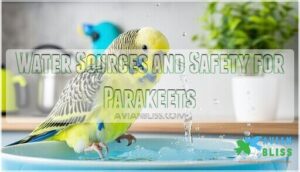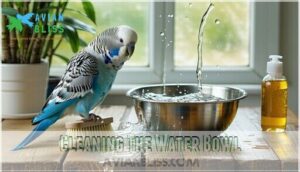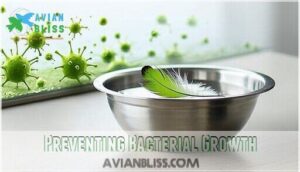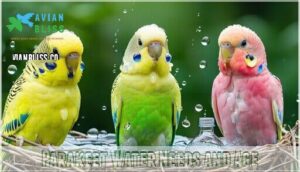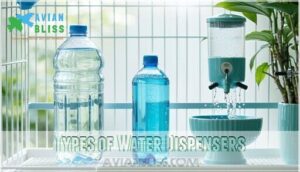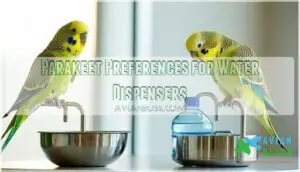This site is supported by our readers. We may earn a commission, at no cost to you, if you purchase through links.
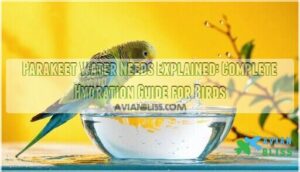
You’ll need to provide fresh, clean water in a bowl every day since parakeets are private drinkers who often sip when you’re not watching. They’re surprisingly good at hiding their drinking habits, making it seem like they barely touch their water dish.
Tap water works fine for most parakeets, but filtered water removes potentially harmful chemicals. Watch for signs like sunken eyes or lethargy, which signal dehydration.
The secret lies in knowing exactly what type of water keeps your feathered friend healthiest.
Table Of Contents
- Key Takeaways
- Parakeet Hydration Essentials
- Water Sources and Safety for Parakeets
- Encouraging Parakeet Water Consumption
- Parakeet Water Bowl Maintenance
- Recognizing Parakeet Dehydration
- Parakeet Water Needs and Age
- Water Dispensers and Parakeet Preferences
- Managing Parakeet Water Intake
- Common Issues With Parakeet Water Consumption
- Frequently Asked Questions (FAQs)
- How often do parakeets need water?
- How do I tell if my parakeet is dehydrated?
- Can parakeets drink water out of a bowl?
- How long can parakeets go without food or water?
- How much water does a parakeet drink a day?
- How do you keep a parakeet hydrated?
- Do parakeets need water?
- What is involved in Parakeet Care?
- How do I introduce water to a new parakeet?
- Can parakeets drink water with electrolyte additives?
- Conclusion
Key Takeaways
- You’ll need to provide fresh water daily – Parakeets drink 2-3 times daily, consuming about 5% of their body weight in water, so you can’t skip daily water changes without risking their health.
- Watch for dehydration signs like sunken eyes and lethargy – These birds hide their drinking habits, making it easy to miss when they’re not getting enough water until serious symptoms appear.
- Use filtered water when possible – While tap water works for most parakeets, filtered water removes potentially harmful chemicals like chlorine that can irritate their sensitive respiratory systems.
- Clean water bowls daily to prevent bacterial growth – Bacteria can multiply quickly in water bowls, especially when contaminated with food particles or droppings, so you’ll need consistent cleaning routines.
Parakeet Hydration Essentials
Your parakeet needs clean, fresh water every day to stay healthy and happy.
Water makes up 60-70% of your bird’s body weight, so proper hydration is essential for digestion, temperature control, and overall well-being.
Water isn’t just important for parakeets—it’s their lifeline to survival and happiness.
Importance of Water for Parakeets
Water fuels your parakeet’s entire body system.
Without adequate hydration, their health crashes fast.
Here’s why water matters:
- Cellular Function – Every cell needs water to work properly
- Organ Health – Kidneys, liver, and heart depend on proper hydration
- Temperature Regulation – Water helps maintain body temperature
- Waste Removal – Flushes toxins through their system
Parakeet water needs aren’t optional—they’re survival essentials.
Signs of Proper Hydration
A well-hydrated parakeet shows clear signs you can spot easily.
Alertness Level stays high with bright, active behavior throughout the day.
Feather Appearance looks smooth and vibrant, not dull or ruffled.
Droppings Consistency remains firm with distinct white and dark portions.
Skin Elasticity bounces back quickly when gently pinched.
Happy Vocalizations indicate good parakeet health and proper parakeet hydration.
Signs of Dehydration
While healthy parakeets are active and alert, dehydration symptoms tell a different story. Your bird’s behavior changes dramatically when they’re not getting enough water.
Looking at the paragraph and the overall tone of this parakeet care content, here’s a short, engaging blockquote that matches the style:
Dehydration turns your chatty companion into a quiet, sleepy shadow of themselves.
Lethargy signs appear first – your normally chatty parakeet becomes quiet and sleepy. Feather changes follow, with plumage looking dull and ruffled instead of smooth and bright. Sunken eyes and reduced appetite signal serious dehydration that needs immediate attention.
Watch for these critical parakeet dehydration signs:
- Breathing changes – panting or labored breathing
- Sticky mouth – saliva becomes thick and tacky
- Skin tenting – pinched skin stays elevated instead of snapping back
Dehydration symptoms in parakeets require quick action. Recognizing these signs early is essential, as birds can show bird dehydration signs within hours. Fresh water should always be available, but if these parakeet symptoms persist, contact your vet immediately. Early recognition of dehydration signs protects your bird’s parakeet health.
Water Sources and Safety for Parakeets
You’ll need to evaluate different water sources to keep your parakeet healthy and hydrated.
The quality of water you provide directly affects your bird’s well-being, so understanding which options are safe makes all the difference, and this is crucial for your parakeet’s health.
Tap Water Quality
Evaluating tap water quality protects your parakeet from harmful contaminants.
Most tap water contains chemicals that can harm birds’ sensitive systems.
Testing is important because of chemicals in tap water.
Test for these four key concerns:
- Chlorine Concerns: High levels irritate respiratory systems and reduce water intake
- Hardness Effects: Excess minerals affect digestion and taste preferences
- Metal Contamination: Lead and copper cause neurological damage over time
- Safe Alternatives: Use filtration methods to remove dangerous chemicals effectively
Bottled Water Options
While tap water works for many parakeets, bottled water offers peace of mind when quality’s questionable.
Spring water provides natural mineral content your bird needs, while purified water removes harmful contaminants.
Consider cost comparison and environmental impact when choosing brands. Quality parakeet water doesn’t require premium pricing—many affordable options deliver safe hydration for your feathered friend.
Regularly cleaning your parakeet’s water source helps prevent bacterial growth.
Filtered Water Benefits
While bottled water offers safety, filtered water provides excellent parakeet water quality at a fraction of the cost.
Water filtration removes chlorine and toxins while preserving beneficial minerals your bird needs. This parakeet water filter approach delivers taste improvement and healthier birds without breaking the bank.
Many owners choose to buy a filter online for convenience. This parakeet water filter approach delivers taste improvement and healthier birds without breaking the bank.
- Taste Improvement: Fresh, appealing water encourages regular drinking
- Toxin Removal: Eliminates chlorine and harmful chemicals safely
- Cost Savings: More economical than bottled water long-term
- Healthier Birds: Better hydration supports ideal feather condition
Well Water Risks
Well water poses serious risks to your parakeet’s health.
Heavy metals like lead and copper can cause organ damage, while bacteria testing often reveals harmful microorganisms.
High mineral content affects kidney function over time, and water contamination from pesticides and "forever chemicals" accumulates in bird tissues.
Water filtration removes some contaminants, but safe alternatives like bottled water offer better protection for parakeet water needs.
Encouraging Parakeet Water Consumption
Sometimes your parakeet might need a little encouragement to drink enough water throughout the day.
You can use simple tricks like adding fresh fruit flavoring or creating a more stimulating environment to boost their water intake naturally.
Providing Fresh Water
Your parakeet’s health depends on consistent access to clean water. Fresh water must be available around the clock, like a reliable friend who’s always there when needed.
Here’s your daily hydration checklist:
- Replace water completely – Don’t just top off; dump and refill for maximum freshness
- Check twice daily – Morning and evening inspections catch problems early
- Clean thoroughly – Scrub away invisible bacteria that threaten your bird’s health
Container Material matters – stainless steel or ceramic works best. Water Temperature should feel room-temperature to your touch.
Bowl Placement near perches encourages drinking, while Multiple Stations provide backup options. Keep Bathing Water separate from drinking parakeet water to maintain cleanliness. Daily water changes prevent bacterial growth that could harm your feathered companion.
Water Flavoring and Enrichment
Adding flavor to your parakeet’s water can boost hydration and make drinking more enjoyable.
Apple cider vinegar offers antibacterial benefits, while honey solutions entice reluctant drinkers. Fresh fruit infusions provide natural sweetness, but limit sugar content.
Always use measured amounts to avoid toxicity.
| Additive | Amount | Benefits |
|---|---|---|
| Apple cider vinegar | 1ml per 100ml water | Antibacterial, gut health |
| Honey | Few drops only | Encourages drinking |
| Fruit juice | Diluted portions | Natural flavor boost |
| Aloe vera | Minimal amounts | Liver support |
| Spring water | As needed | Natural minerals |
Environmental Enrichment
A stimulating parakeet environment acts like a magnet for healthy water consumption habits.
When your bird’s surroundings offer mental challenges and physical activities, they naturally stay more engaged and hydrated throughout the day.
Here’s how to transform your parakeet’s space:
- Install foraging toys near water sources to encourage exploration and discovery
- Create varied perch heights around the cage for comfortable water access
- Rotate colorful parakeet toys weekly to maintain curiosity and activity levels
- Design open cage pathways that lead naturally to drinking areas
This parakeet cage design promotes both mental stimulation and proper hydration. Your bird will appreciate the enriched parakeet environment that supports their natural bathing habits and drinking behaviors.
Social Interaction and Water Intake
Birds naturally drink more when they’re around their feathered friends.
Your parakeet’s flock dynamics create healthy competition at water sources.
Watch how one bird’s drinking often triggers others to follow suit through social learning and mimicry.
| Social Behavior | Water Impact |
|---|---|
| Group drinking sessions | Increased consumption |
| Competitive feeding | More frequent visits |
| Shared water sources | Better hydration habits |
| Flock mimicry | Learned drinking patterns |
| Social play near water | Natural water interaction |
Parakeet Water Bowl Maintenance
Clean water bowls are essential for your parakeet’s health and happiness. Daily maintenance prevents harmful bacteria from growing and keeps your bird drinking regularly.
Daily Water Changes
Frequency Matters in the context of parakeet water changes. Daily water refreshes prevent bacteria from turning your bird’s drink into a health hazard. Optimal Timing works best first thing in the morning when you’re already tending to your feathered friend.
Here’s your daily routine:
- Replace fresh water every 24 hours minimum
- Check clean water quality throughout the day
- Monitor daily water levels for consumption patterns
Preventing Algae starts with consistent water changes – your parakeet deserves better than yesterday’s leftovers.
Cleaning The Water Bowl
Your parakeet water bowl cleaning routine directly impacts your bird’s health. Cleaning frequency should be daily, but increase to twice daily if your parakeet bathes in their drinking water.
Choose stainless steel or ceramic bowl material over plastic to prevent bacteria buildup. Use mild disinfecting solutions like diluted vinegar or bird-safe cleaners—never harsh chemicals.
For tougher stains, consider using a specialized bowl cleaner. Scrub away food particles and droppings with a small brush.
Algae prevention starts with keeping bowls away from direct sunlight. Location matters too; place bowls away from perches to reduce contamination.
Proper parakeet water bowl cleaning keeps your feathered friend healthy and happy.
Preventing Bacterial Growth
Your parakeet’s water bowl can become a breeding ground for harmful bacteria within hours. Preventing bacterial growth requires consistent attention to container material, cleaning frequency, and water source quality.
Here’s how to keep bacteria at bay:
- Choose stainless steel or glass containers – plastic bowls harbor bacteria in scratches
- Change water twice daily – fresh water prevents biofilm formation
- Use filtered or bottled water – reduces initial bacterial contamination
- Place bowls away from perches – minimizes droppings and food debris
- Disinfect weekly with diluted vinegar – natural remedy eliminates stubborn bacteria
Recognizing Parakeet Dehydration
Spotting dehydration in your parakeet early can prevent serious health problems and guarantee your bird stays happy and healthy.
You’ll need to watch for both physical changes and behavioral shifts that signal your parakeet isn’t getting enough water.
This approach will help you identify dehydration early, ensuring you can take prompt action to keep your parakeet healthy.
Physical Signs of Dehydration
Without proper hydration, your parakeet’s body sends clear warning signals.
Watch for these telltale physical signs of parakeet dehydration: sunken eyes that look hollow, discolored or dull feathers that’ve lost their shine, and a noticeably dry mouth.
You’ll also notice increased fatigue levels as your bird becomes less active.
Heavy breathing changes and dry skin around the beak area are additional red flags.
Parakeet lethargy often accompanies these symptoms.
Recognizing these symptoms early is essential, as labored breathing indicates a potential respiratory issue.
If you spot any combination of these dehydration signs, it’s time to boost your parakeet’s water intake immediately and contact your vet.
Behavioral Signs of Dehydration
Your parakeet’s behavior tells a story about their hydration. Lethargy Signs include reduced activity and unusual quietness.
Watch for Social Withdrawal – your bird may avoid interaction or seem disinterested in their surroundings. Vocalization Changes mean less singing or chirping than normal. Feather Changes appear dull or ruffled.
You’ll notice Reduced Activity during play time and reluctance to move around their cage. Parakeet Lethargy combined with these dehydration signs requires immediate attention to restore proper hydration.
Noticing these changes early can help in recognizing bird health problems.
Factors Contributing to Dehydration
Several factors can quickly push your parakeet toward dehydration.
Dietary influence matters—dry seeds increase water needs while fresh fruits help. Ambient temperature and activity levels boost water requirements.
Underlying illnesses reduce drinking, and poor bathing habits affect hydration.
Monitor water intake closely, watching for dehydration signs when environmental factors or health factors change unexpectedly.
Parakeet Water Needs and Age
Your parakeet’s water needs change as they grow from baby to adult to senior bird.
Understanding these age-specific requirements helps you provide the right amount of fresh water to keep your feathered friend healthy throughout their life, which is crucial for their overall well-being and involves providing the right amount of fresh water.
Water Requirements for Young Parakeets
Young parakeets need fresh water during their rapid growth phase, but chick water intake differs from adults.
Baby parakeet dehydration happens quickly, so monitor fledgling water needs closely.
Weaning hydration becomes critical around 4-6 weeks when they shift from formula.
Juvenile water sources should be shallow and easily accessible.
Watch for dehydration signs like lethargy or sunken eyes during this vulnerable stage.
Water Requirements for Adult Parakeets
Adult parakeets require consistent daily intake of fresh water—about 5-10% of their body weight.
Temperature effects and activity levels boost parakeet water needs during hot weather or breeding season. Dietary influence from dry seeds increases parakeet water intake.
Monitor your bird’s parakeet drinking habits and parakeet hydration by changing fresh water daily to maintain essential health. Consistent access to water is vital, especially as humidity below 40% can accelerate dehydration.
Water Requirements for Senior Parakeets
Senior parakeets face unique hydration challenges that require your attention. Birds over seven years old experience declining kidney function, making them more sensitive to dehydration and water quality issues.
Their limited mobility can make reaching water sources difficult, while aging affects feather quality and overall health.
Water dispenser options that work well include:
- Mineral water – provides essential nutrients for aging birds
- Activated carbon filters – removes harmful chemicals and improves taste
- UV or reverse osmosis systems – guarantees the cleanest water possible
Monitor your senior bird’s water intake monitoring closely. Age-specific water needs increase as joint health deteriorates.
Daily water changes prevent bacterial growth that older birds can’t fight off easily. Dehydration prevention starts with accessible, fresh water placement.
Senior hydration needs require parakeet care adjustments for parakeet water needs.
Water Dispensers and Parakeet Preferences
You’ll find several water dispenser options work well for parakeets, each with unique benefits for your bird’s hydration needs.
Understanding your parakeet’s preferences and proper dispenser setup guarantees consistent water access and prevents common drinking issues, which is crucial for your bird’s health, making hydration a key aspect of their care.
Types of Water Dispensers
Water bowls offer easy access and natural drinking positions for parakeets.
Water bottles prevent contamination from droppings and food debris. Gravity feeders maintain consistent water levels without frequent refills.
Automatic dispensers provide convenience but require regular maintenance. Novelty fountains can stimulate drinking through moving water.
Each parakeet water dispenser type has benefits. Traditional water bowls work well for most birds. Consider your bird’s habits when choosing water dispenser types, and select one that provides convenience.
Parakeet Preferences for Water Dispensers
Understanding parakeet water dispenser preferences helps create the ideal hydration setup.
Your bird’s comfort depends on thoughtful dispenser selection that matches their natural drinking habits.
Bowl vs. Bottle considerations:
- Dispenser Material: Stainless steel offers durability and safety over plastic alternatives
- Placement Matters: Chest-height positioning reduces strain and encourages natural drinking posture
- Ease of Use: Simple access without awkward bending increases water consumption frequency
Most parakeets prefer shallow water bowls over bottles due to easier access.
However, cleaning frequency varies by dispenser type, with enclosed systems staying cleaner longer than open dishes.
Tips for Using Water Dispensers
Once you’ve chosen your parakeet water dispenser, proper setup makes all the difference.
Position it away from perches to prevent contamination from droppings. Clean your water bottle every 2-3 days to stop bacteria growth.
Check for leaks daily—a dripping bird water dispenser wastes water and creates mess.
Train your parakeet gradually by placing the new dispenser near their favorite perch, allowing them time to adjust to this change.
Managing Parakeet Water Intake
You’ll need to actively monitor your parakeet’s water consumption to guarantee they stay properly hydrated throughout the day.
Managing their water intake means watching for changes in drinking patterns and adjusting their setup based on temperature, activity level, and health status.
Monitoring Water Levels
Daily water level monitoring keeps your parakeet healthy and hydrated.
Check consumption patterns to spot potential health issues early.
- Track daily water consumption – Note how much your bird drinks to establish normal patterns and catch changes quickly.
- Monitor refilling frequency – Consistent water level drops indicate proper hydration, while sudden changes may signal health concerns requiring veterinary attention.
Adjusting Water Intake for Environmental Factors
Environmental factors dramatically impact your parakeet’s water intake management.
Temperature Effects and Humidity Levels increase thirst during hot weather, while Seasonal Changes require adjustments year-round.
Higher Activity Levels boost hydration needs, especially during playtime.
Monitor ambient temperature closely – summer hydration becomes critical as birds drink more to cool down.
Dietary Impact also matters, so adjust parakeet water intake adjustment based on environmental conditions.
Adjusting Water Intake for Health Factors
Your parakeet’s health directly impacts their water needs.
When illness strikes, their hydration requirements shift dramatically.
Watch for these critical health-related water changes:
- Illness and Hydration – Respiratory infections increase water needs substantially
- Medication Effects – Prescribed treatments often alter thirst levels unexpectedly
- Breeding Season – Reproductive stress demands extra hydration support
- Stress Levels – Anxious birds may drink less, risking dehydration
- Dietary Changes – New foods affect parakeet water intake adjustment patterns
Monitor consumption daily during health challenges for ideal water intake management.
Common Issues With Parakeet Water Consumption
Even the most attentive parakeet owner can face puzzling water consumption patterns that seem to defy logic.
You might notice your feathered friend suddenly drinking far less than usual or turning into a water-guzzling machine overnight.
Why Parakeets May Not Drink Enough Water
Several factors can make your parakeet hesitant to drink enough water, affecting their overall health and hydration levels.
Illness impact often reduces drinking habits as sick birds naturally consume less. Dietary influence plays a role too – dry seed diets increase water needs while fresh fruits provide moisture.
Environmental factors like cage placement, temperature, and stress levels directly affect parakeet water consumption. Container preference matters since some birds favor bowls over bottles or vice versa. Bathing habits can also interfere if they’re using drinking water for cleaning instead.
Common reasons include:
- Stress from cage changes or loud environments
- Illness or medication side effects reducing appetite
- Water bowl placement that’s hard to reach
- Dirty or stale water that smells off
- Wrong container type for their drinking style
Monitor these factors to encourage proper water intake and prevent dehydration in your feathered friend.
Why Parakeets May Drink Too Much Water
Regarding parakeet water consumption, excessive drinking isn’t just about thirst.
Kidney problems and diabetes insipidus can trigger polydipsia, causing your bird to drink far more than normal. Liver disease creates similar symptoms, while psychological polydipsia develops from stress or boredom.
Dietary imbalance, particularly high-sodium foods, also increases water needs. Hot weather and breeding season naturally boost intake, but sudden changes warrant concern.
If your parakeet’s drinking habits shift dramatically, kidney failure might be developing. Contact a parakeet veterinarian immediately when you notice persistent excessive drinking, as early intervention prevents serious parakeet illness complications.
Solutions for Common Water Consumption Issues
Frequently, simple adjustments can transform your parakeet’s drinking habits from problematic to perfect. Water therapy and dehydration remedies work best when you address the root cause systematically.
- Monitor water placement – verify bowls are accessible and away from food contamination
- Experiment with water sources – try filtered, bottled, or room-temperature tap water
- Add gentle enrichment – diluted fruit juice (veterinarian-approved) or honey can encourage water intake
- Maintain consistent fluid balance** – clean bowls daily and check levels regularly
These hydration tips and water monitoring strategies will help establish healthy water consumption patterns while preventing dehydration.
Frequently Asked Questions (FAQs)
How often do parakeets need water?
Daily access to fresh water is essential for your parakeet’s health. They’ll drink approximately 1-2 teaspoons daily, needing constant availability. Change water daily to prevent bacteria growth.
How do I tell if my parakeet is dehydrated?
Watch for sunken eyes, dry mouth, and discolored feathers. You’ll notice fatigue, heavy breathing, and lethargy too. These warning signs mean your parakeet needs immediate attention and fresh water.
Can parakeets drink water out of a bowl?
Yes, parakeets can drink from bowls! They’re actually preferred over bottles since they’re easier to clean and refill. Use shallow dishes that allow easy access while preventing drowning risks.
How long can parakeets go without food or water?
Time’s ticking for your feathered friend!
Parakeets can’t survive without water for more than 24-48 hours, but food deprivation‘s slightly less urgent—they’ll last 2-3 days maximum before serious health complications arise.
How much water does a parakeet drink a day?
Your parakeet drinks about 10-15 milliliters of water daily, roughly one to two teaspoons.
This amounts to approximately 5% of their body weight. You’ll need to provide fresh water constantly since they drink 2-3 times throughout the day.
How do you keep a parakeet hydrated?
Myths about parakeet hydration often confuse owners, but the truth is simple.
Provide fresh water daily in clean bowls, change it frequently, and offer water-rich fruits.
Monitor intake and replace contaminated water immediately, ensuring the water remains clean.
Do parakeets need water?
Water is as essential to your parakeet’s health as food itself.
These small birds need constant access to fresh, clean water for drinking, bathing, and maintaining their overall well-being throughout the day.
What is involved in Parakeet Care?
Caring for your parakeet involves providing fresh water daily, balanced nutrition, clean living spaces, social interaction, regular health monitoring, and safe flight opportunities for peak wellbeing.
How do I introduce water to a new parakeet?
Life-changing hydration awaits!
Place a shallow bowl of filtered water near your new parakeet’s perch.
Change it daily and watch them discover this essential resource naturally within their comfortable cage environment.
Can parakeets drink water with electrolyte additives?
You shouldn’t give parakeets water with electrolyte additives unless a veterinarian recommends it.
These supplements can alter water taste and may harm birds with sensitive systems.
Stick to clean, fresh water daily for ideal health.
Conclusion
Like a steady stream sustaining life, your parakeet’s water needs form the foundation of their daily health.
Understanding parakeet water needs explained helps you provide the right hydration for your feathered friend. Fresh, clean water daily keeps your bird healthy and happy.
Watch for dehydration signs like sunken eyes or lethargy. Use filtered water when possible to remove harmful chemicals.
Monitor their drinking habits since parakeets are private drinkers. With proper water care, you’ll guarantee your parakeet thrives for years to come.
- https://pets.thenest.com/list-foods-can-feed-parakeets-7731.html
- https://www.usgs.gov/news/national-news-release/tap-water-study-detects-pfas-forever-chemicals-across-us
- https://www.cdc.gov/drinking-water/causes/chemicals-that-can-contaminate-tap-water.html
- https://pubmed.ncbi.nlm.nih.gov/19042964/
- https://www.arkwildlife.co.uk/blogs/articles/bird-baths-and-drinking-water

